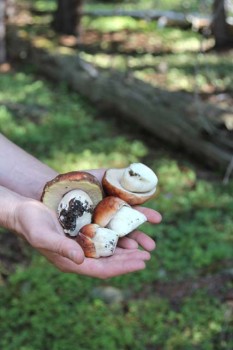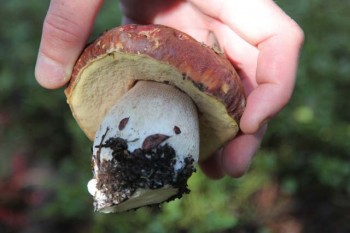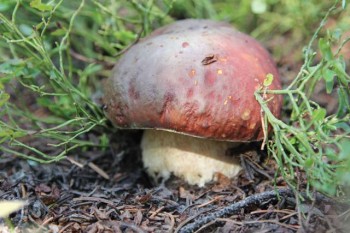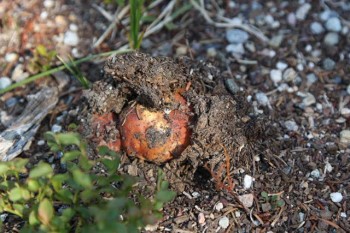
Since late July, my dear friend Butterpoweredbike has been emailing me about finding pounds upon pounds of porcini.
Meanwhile, in the last month and a half, I moved to a new home and a new job while trying to finish up my old jobs, working 100 hours per week or more, ad infinitum. What a change from the fancy-free wild food forager I formerly was!
So I lived vicarously through her finds, and this year, Butter did it right—she figured out the favorite forest conditions of the Rockies’ prize fungus, then consulted her maps and with a little help descended upon prime locations that rendered unto her a porcini windfall of staggering proportions. (This is in great contrast to the awkward fumbling we both did last year in the early days of our mushroom hunting obsessions, which were, coincidentally, the early days of our friendship.)
Still, despite being embroiled in a staggering amount of work at my new job, I made a point to search my spots when time permitted, generally one morning per week—but came up empty handed each time.
That was until two weeks ago, when Gregg and I found seven or eight young kings at our favorite porcini place.
Interestingly, the timing coincided with Butter’s pronouncement that porcini season was over.

Pleased as a peacock, however, I proceeded to write a proud porcini piece for my new publications—the Friday Scene section of the Summit Daily News in Summit County, Colorado, and the Explore Summit Weekender, a glossy weekly rag we do in the summer and winter peak seasons—pronouncing the arrival of mushroom season.
Therein I described the king of kings:
“Also called king boletes, porcini (Boletus edulis) are known for their wine-colored caps, under which is a spongy pore mass instead of gills. The stalks of these Rocky Mountain favorites are bulbous and white with a pattern of fine netting, and they can grow to the size of a dinner plate,” I wrote.
Since then, you know what happened? I’ve found but one two-headed baby porcini—two funny, stuck-together Siamese twin princes with bitey marks on their thick red-orange heads—despite all the other ‘shrooms that have been making an appearance.
So now I ask myself and I ask you too: Is Rocky Mountain porcini season over?

Permit Required
Lest I do a disservice to the Forest Service, let me repeat that foraging for fungus in the White River National Forest in and around Summit County — including areas that were once part of the Arapahoe National Forest — requires a free mushroom permit for personal use. These are available at the Dillon Ranger District, 680 Blue River Pkwy. in Silverthorne, and entitle holders to 5 gallons of mushrooms per day — the equivalent of one 5-gallon bucket or two grocery sacks — with a total season limit of 67 pounds. Foraging ethics dictate not taking all the mushrooms found in a given spot, but leaving enough so they can regenerate.
Tools of the Trade
A good mushroom hunter’s toolkit includes several local mushroom guides for cross referencing identifications, a camera for further study, a knife to slice a mushroom neatly at its base and a basket or pillowcase in which to carry your finds.
Consuming wild mushrooms is not to be taken lightly. Consider the case of author Nicholas Evans, who served foraged mushrooms to a party of family members after he and his brother-in-law mistakenly put their faith in each other’s tentative identifications of ceps (another name for Boletus edulis) without confirming identification, and ended up serving poisonous Cortinarius speciosissimus (deadly webcap) instead. The consequence was grave: kidney failure for both men and Evans’ wife.
The sometimes-hard-to-find local guidebook, “Mushrooms of Colorado and the Southern Rocky Mountains” by Vera Stucky Evenson is a good bet for information on both edible mushrooms and poisonous look-alikes, if any, in the region, as well as procedural info for identifying, studying and confirming mushroom finds. Or, join the Colorado Mycological Society and take part in forays with mushroom experts. Other resources include the Sam Mitchel Herbarium of Fungi at the Denver Botanic Gardens, which is curated by Evenson and www.mushroomexpert.com.

Secret Spots
After obtaining a permit, tools and a good education in edible versus toxic mushrooms, the only thing left to do is find the buggers. This can be trickier than one might expect.
Ask a mushroom hunter where to go, for example, and the request is likely to fall on deaf ears. That’s because mushroomers are a secretive bunch, often stealing out in the early morning light so as not to reveal their special spots, and to make sure they get there before you do.
Still, you can break into the mycophagist club with the right combination of legwork and love. Here are a few hints to get you started:
- If it’s porcini you seek, head high and look among the conifers.
- If you spy mushrooms — any mushrooms — that’s a good sign.
- Look for signs of fungus hunters before you: cut stalks, or sadly, mushrooms that have been kicked over. It probably means you’re in the right zone.
- Walk carefully, studying everything, consulting your guidebooks.
- Enjoy the journey; treasuring the small things you find, even if not mushrooms. There is no luckier mushroom hunt than one inspired by the joy of the moment.
For More Information
The above entry is a much-adapted piece from the SDN publications. Here’s a link to the article as it originally appeared a few weeks ago in the Weekender. Once you get there, choose the 8/24/12 publication date in the drop down menu, the issue with the hot air balloon on front, and navigate on over to page 14.
For more porcini prattle, don’t miss Butter’s site: www.hungerandthirstforlife.blogspot.com.
And for ongoing wild food discussion via photos and short observations, which I now generally post generously on weekends in lieu of the more time-consuming blog posts, check out my FB page at www.facebook.com/wildfoodgirl.
Cheers, y’all!

Hi,
The drought may have had something to do with the slim pickings, but here comes September! Yay! (one hopes)
Always a pleasure reading your articles.
Thanks JJ. Much appreciated–both the kind words and the portent of porcini yet to come.